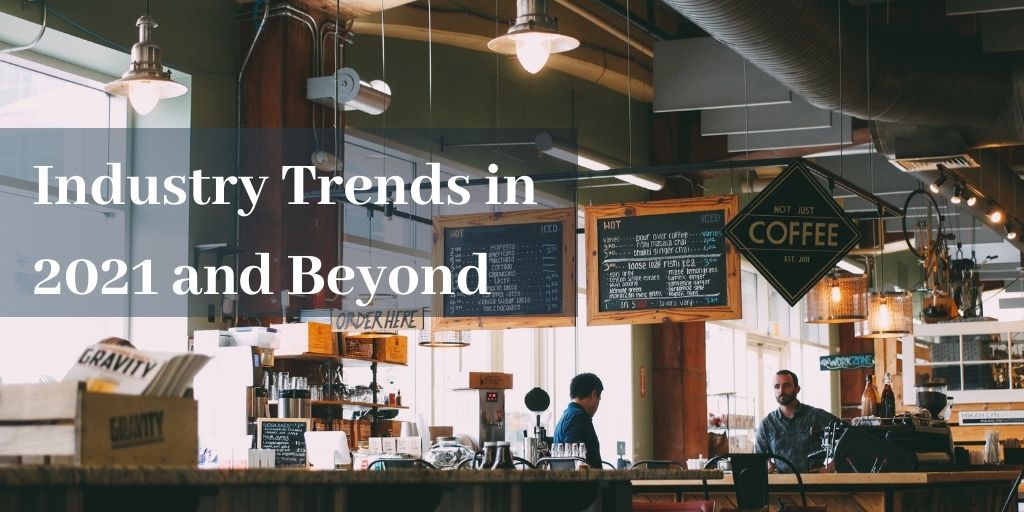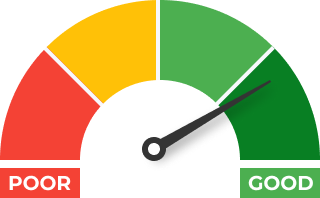Let’s face it – nobody expected 2020 to turn out this way. The National Restaurant Association forecast a 4% increase in sales in 2020, a jump from 2019 thanks to a boom in the economy and positive consumer sentiment. As we all know, 2020 did not go according to plan. Almost 12 months on, the same association has found that one in 6 restaurants, representing close to 100,000 establishments, have closed either long-term or permanently with a loss prediction of 240 billion USD by end of the year.
When it comes to the bar industry, the news hasn’t been much better. With strong revenue growth from 2015-2019, the large impact of 2020 canceled out all positive steps over the last 4 years, leading to an overall decrease in revenue.
But it isn’t all doom and gloom. With the Covid-19 vaccine administered in a number of countries, there are hopes for a smooth roll-out which should start us on the road back to normal.
This is a long post. Grab the PDF version so you can save it for review later.
A changing industry
Restaurants and bars have been forced to pivot in order to stay afloat this year. The most common theme was switching to online ordering for pick-up or delivery. UberEats has seen a revenue increase of 100% and Grubhub’s sales are up by over 40%. Restaurants who previously shied away from take-away quickly set themselves up for delivery in order to stem the losses from lack of footfall. And consumers are ordering more than ever. Technomic’s report ‘Menu Monitoring during the Covid-19 Pandemic’ states that 46% of consumers said they ordered from restaurants – and this number is set to increase.
Key focus going forward
2021 will be focused on making customers feel comfortable enough to go to restaurants and bars. This starts with understanding the underlying worries and concerns associated with dining and drinking outside of the home and promoting your establishment as a place that can allay those fears.
1. Safety measures will drive online reviews
Podium’s ‘2020 State of Reviews’ declares that reviews have ‘never been so important or influential’ and that 3.4 is the average star rating consumers require in order to consider engaging with a business. Reviews are also becoming increasingly important for last-minute decisions with 28% of survey respondents saying they look up reviews while standing outside the establishment. Online reviews cannot, and should not, be ignored by restaurants and bars.
In the pre-pandemic era, priorities were different. The top 3 searches consisted of quality, price, and customer service. However, now the focus centers heavily around safety measures such as social distancing and mask-wearing policies. Although previously unheard of, Podium’s survey respondents identified them as among the most important features they look for in reviews. Over 25% of all survey respondents said that a company’s social distancing policies are among the most important considerations when choosing a local business.
This is enough to show that a restaurant or bar’s safety measures should be stringent and enforced. Even if customer service is slightly below-par, 45% of respondents who might otherwise leave a negative review would consider refraining from doing so, as they understand that local businesses are facing many issues in this climate. However, the second most popular reason to leave a 1-star review is unsafe COVID-19 measures. Restaurants and bars can afford for their customer service to be less than spectacular but they will suffer online if they are not enforcing safety measures.
So what can you do to earn positive reviews? Heightened cleanliness will be of paramount importance with employees constantly disinfecting communal surfaces. Mask wearing by employees and distanced tables will also be critical. Every safety measure that you take should be highlighted and advertised so that the customer can see and appreciate all that you are doing.
A bad review shouldn’t be cause for panic, but for reflection. Restaurants and bars should learn from the comments and improve, as well as responding directly to the review. 56% of people asked said their opinion about a business changes due to the review responses so it is possible to win customers back after a subpar experience.
2. Technology boom
If we have learned anything from this pandemic, it is that touching items that many hands have touched before is not good! So where does this leave restaurants and bar menus? Most establishments did a great job of quickly implementing QR codes but the desire for contactless operations remains.
Contactless technology is the answer to maintaining the health and safety of staff and customers alike. A recent VIPInsiders survey states that 61.9% of customers want their waiters to wear protective equipment and have contactless options whenever possible. Payments will be card-only and ordering could be done virtually – until people begin to feel more comfortable and the vaccine is rolled out across the globe.
3. Delivery remains
As mentioned previously, online ordering and delivery are set to rise as it will take time for hospitality establishments to regain their trust. Drink orders will endure so bars will continue to offer curbside pickups and delivery. Transport-friendly formats like canned wines, bottled cocktails, and boxed beer will grow. Packaging will also get more creative and interesting as restaurants and bars will invest more in products that directly reflect their brands.
On this note, restaurants will start to launch their own delivery programs and rely less on 3rd party apps. This shift has already begun as 84% of restaurant owners have learned that the 3rd party fees are often not worth the extra increase in business the apps bring. Many POS systems include online order integration to allow restaurants to organize their own deliveries without needing to work with external partners.
Source: Technomic report
4. Loyalty and reward programs
A recent report from Paytronix Systems and PYMNTS.com stated that approximately 93 million consumers would spend more if restaurants and bars offered loyalty programs. 86 million restaurant and bar customers currently use loyalty programs and 44.2 million more would if restaurants offered them.
That’s a lot of potential new customers. 2021 will see a plethora of new loyalty and reward programs launched for restaurants that are currently without. We may even begin to see loyalty partnerships with local restaurants, bars, and cafes forming collaborations to boost spending.
5. Healthy products
2020 saw a heavy reliance on baking, food ordering, and alcohol. Customers will want to reverse this in 2021 and they will lean more towards healthier food and drink items. The International Food Information Council’s 2020 Food & Health Survey findings highlight that 54% of all consumers place more importance on the health values of their food and beverage choices in 2020 than a decade ago. Keep in mind that 18% of Americans use an app to monitor their activity and food consumption and post-pandemic, and this number is set to rise.
Restaurants and bars should put a heavy focus on providing more healthy menu choices than ever before in order to capitalize on this fast-growing trend. Younger generations will pay more for healthy food and drink – make sure you highlight these items on your menu to increase visibility. Large Quick Service Restaurant organizations are also racing to implement healthy options on their menus – just take a look at Burger King offering the Impossible Whopper and McDonalds launching McPlant – a line of plant-based products.
6. Sustainable and local
Local products and sustainability have been on every top trends list for the past 5 years. However, the reasoning behind has changed. We see the impact of relying on products traveling to reach us – and we have had enough of empty supermarket shelves. We are less global in 2020, which leads to customers taking a more local outlook. As consumers look to undo some of the environmental harm that was done during the pandemic, sustainability is set to take center stage. Restaurants and bars will focus on sourcing as many products locally as possible in order to reduce their carbon footprint. Expect to see an increase in local distilleries making innovative new products and a return to customers ordering locally created drinks.
This can also be a great marketing tool to reach the growing number of ‘climatarians’ – people who change their eating habits to reduce their global footprint.
7. Focus on flexibility
2020 has made us wary of planning for the future. We don’t want to make plans too far in advance as we have been traumatized by sudden lockdowns and restrictions. When it comes to restaurants and bars, flexibility is key. Owners must have back-up plans if a similar situation strikes again, and also create customer-friendly cancellation policies.
As staff numbers have dropped drastically over the past few months, job flexibility will also be key. There will be no surplus headcounts, so employees will need to be proficient in a number of different roles. Cross-training will be crucial in training employees to perform multiple jobs. An upside of the reduced staffing is that there will be more qualified people in the job market, so restaurant and bar owners will be able to hire the crème de la crème.
8. Staff care
As more qualified staff will be on the job market, restaurants and bars should also take this opportunity to tackle the problem of high-turnover, prevalent throughout the industry. Expect many major brands to start offering competitive packages for staff retention and clear career growth paths to avoid going back to the old routine of hiring and firing on a regular basis. Although we will see an increase in contactless operations, once people begin to feel more comfortable dining out, the need for human contact and personal touch will be strong across the restaurant and bar industries.
9. Staying connected
Covid-19 has, in some ways, brought customers closer to their favorite hang-outs. GoFundMe’s have been set up to save restaurants and bars across the United States. Zoom cocktail workshops or cooking classes have become the norm. Even though most of us will be happy never to use Zoom/Google Hangouts ever again, bars and restaurants shouldn’t lose these connections. 2021 will see an increase in in-person classes and workshops in order to increase customer loyalty.
10. Creative solutions and redesign
There have already been a plethora of creative ideas in the bar and restaurant industry in 2020. From selling DIY meal or cocktail kits to adding groceries to their menu, restaurants, and bars have been coming up with innovative ways to earn money and remain open. This is set to continue over the coming months. Expect to see socially distanced block parties/dinners organized by local establishments, an increase in branded merchandise, and smaller yet changing menus in order to satisfy the customers venturing out or ordering in.
Another trend that falls under creativity is the re-imagination of restaurant space design. Post-pandemic, restaurants will need to rethink how their space is used and what areas are designated for tables, pick-up areas, and production. Starbucks is creating a number of walk-through locations and Taco Bell is expanding its drive-thru capabilities. Going forward, we will also see restaurants reducing the footprint and geo-locations of future developments.
11. Catering and events
Another way of increasing revenues will be in catering and events. Restaurants and bars will increase the use of their existing capabilities to gain additional income. This is a good way to hedge risk and provide a source of revenue should regulations change going forward.
12. Ghost kitchens
Ghost kitchens are rapidly becoming a popular phrase in 2020. A ghost kitchen is a food preparation facility that is set up for brands that deliver food and that do not need a brick-and-mortar location for dining. This trend is backed up by SoftBank’s recent $120m investment in Ordermark – “a decentralized ghost kitchen“. Uber founder Travis Kalanick has also been heavily investing in real estate properties for CloudKitchen – his ghost kitchen operation.
Although some virtual brands like to have their own kitchen, often set up in an industrial lot, we will see a rise in shared kitchens. If a restaurant is only open in the evening, they can offer their kitchen to a company that sells breakfast or lunch. This will help cut down on rent costs for both parties and hopefully lead to profitable collaborations between businesses.
13. Consolidation
As we start to see the financial impact that restaurants and bars have incurred during the pandemic, there will be further closures of smaller establishments that have simply not made enough to make it through. Bigger players and surviving businesses will buy these at low prices, leading to a consolidation in the market.
Conclusion
Many analysts are optimistic when it comes to 2021, but it won’t be an easy journey to get back to normal. Restaurant and bar managers have to be creative and open to change to survive.
Our recommendations? Keep on top of trends and join online communities for bar and restaurant workers. You can ask questions, share experiences, or provide tips to your peers in a similar situation. You can find our list of recommended websites here. Keep up to date with industry blogs such as Uncorkd, Eater, and, of course, Glimpse.
Listen to your customers and their struggles. Maybe you can come up with a solution to help. Hear their safety concerns about going out for dinner or drinks. The likelihood is that other people will feel the same way. If you can address these concerns, then they will feel confident to come to you. Think about what their experience will be like, what fears or concerns they may have and the value they place on the experience of going out. Using this approach of staying close to your customers and their needs, you won’t go far wrong.
This is a long post. Grab the PDF version so you can save it for review later.









 +1 (786) 292-2373
+1 (786) 292-2373 insights@glimpsecorp.com
insights@glimpsecorp.com





